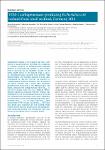VIM-1 carbapenemase-producing Escherichia coli isolated from retail seafood, Germany 2016
Roschanski, Nicole
Guenther, Sebastian
Vu, Thi Thu Tra
Fischer, Jennie
Semmler, Torsten
Huehn, Stephan
Alter, Thomas
Roesler, Uwe
Carbapenems belong to the group of last resort antibiotics in human medicine. Therefore, the emergence of growing numbers of carbapenemase-producing bacteria in food-producing animals or the environment is worrying and an important concern for the public health sector. In the present study, a set of 45 Enterobacteriaceae isolated from German retail seafood (clams and shrimps), sampled in 2016, were investigated by real-time PCR for the presence of carbapenemase-producing bacteria. One Escherichia coli (ST10), isolated from a Venus clam (Ruditapes philippinarum) harvested in the Mediterranean Sea (Italy), contained the carbapenemase gene blaVIM-1 as part of the variable region of a class I integron. Wholegenome sequencing indicated that the integron was embedded in a Tn3-like transposon that also contained the fluoroquinolone resistance gene qnrS1. Additional resistance genes such as the extended-spectrum betalactamase blaSHV-12 and the AmpC gene blaACC-1 were also present in this isolate. Except blaACC-1, all resistance genes were located on an IncY plasmid. These results confirm previous observations that carbapenemase- producing bacteria have reached the food chain and are of increasing concern for public health.
No license information

